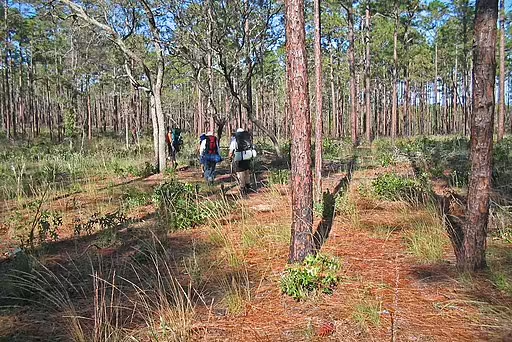Pineland Milkweed (Asclepias obovata) is a herbaceous perennial that is native to the south-central and southwestern United States. This plant is a host to the Queen (Danaus gilippus) and Monarch (Danaus plexippus) butterflies. Growing from 0.5 to 3 feet tall, this species has greenish-yellow flowers that bloom from June to August. It is hardy in zones 7-10.
Table of Contents for Pineland Milkweed (Asclepias obovata)
Taxonomy and Naming of Pineland Milkweed (Asclepias obovata)


Taxonomy
Pineland Milkweed (Asclepias obovata) was originally named and described by Joseph Elliott, an American botanist, in 1817. This species has been named other names but currently has the original name. This species is a member of the Dogbane Family (Apocynaceae).
Meaning of the Scientific and Common Names
Scientific Name
The genus name, Asclepias, is named for the Greek god of healing, Asklepios (Flora of Wisconsin). The species name, obovata, is Latin for egg-shaped or oval (Wikipedia).
Common Name and Alternative Names
The common name comes from the habitat where this plant is found. Another common name is sand milkweed (Sundell 1988), also describing the habitat of the plant.
Physical Description of Pineland Milkweed (Asclepias obovata)

Description
- Plant Type: This plant is a herbaceous perennial
- Height: 0.5 to 3 feet
- Stem: The stem is ascending, simple, and slightly pubescent (Woodson 1954).
- Leaves: The leaves are opposite, sessile, simple, revolute, and filiform in shape. The leaves are 2 to 4 inches long and about 1 to 2 inches wide.
- Flower color: greenish-yellow (Woodson 1954) with a purplish hood
- Blooming period: This plant blooms from June to October.
- Fruiting type and period: This plant has follicles that mature in the late summer and fall.
Range of Pineland Milkweed (Asclepias obovata) in the United States and Canada

This milkweed species is native to the south-central and southeastern United States. It is considered to be rare in the state of Arkansas.
Habitat

This species grows in sandy pinelands and open areas such as fields and roadsides (Woodson 1954). In Texas it is described as growing in post oak savannas and coastal prairies (Singhurst and Hutchins 2015). In Arkansas it has been found on railroad right-of-ways and roadside prairie remnants (Sundell 1989) and prairies in Oklahoma (Waterfall 1950). In Alabama it has been described from dry open woods (Lelong 1977) and pastures (Mohr 1901).
Hosted Insects
This species is a host for the Monarch Butterfly (Danaus plexippus), the Queen Butterfly (Danaus gilippus).
Other Supported Wildlife

This species is a nectar source to other butterflies, skippers, bees, and wasps during the growing season.
Frequently Asked Questions about Pineland Milkweed (Asclepias obovata)
Is this plant poisonous?
Like other milkweeds, it has cardiac glycosides (cardenolides) and is considered to be poisonous with ingestion.
Does this plant have any ethnobotanical uses?
The Native American Ethobotanical Database does not specifically mention this species, but milkweeds in general have been used for foods, pharmaceuticals, and fibers.
How is this plant distinguished from other milkweeds?
This species is often compared to the green comet milkweed (Asclepias verticillata) and some have thought it to be a variety of it. However green comet milkweed is taller and has a hemispherical inflorescence (Singhurst and Hutchins 2015) distinguishing it from this species. Sundell 1989, additionally states that pineland milkweed is distinguished by its pubescence.
Is this plant invasive?
This plant has not been described as invasive in the literature.
Gardening with Pineland Milkweed (Asclepias obovata)

Hardiness
This species is hardy in zones 7-10. If your garden is within these zones and you have the right growing conditions (soil, moisture and exposure), you may well be able to grow this plant. However, if planted outside of its range, the hosted species may not recognize the plant or be harmed by ingesting a different species with an unfamiliar chemical composition.
Optimal Conditions
This species grows best in places where it can receive full sun and has well-drained soil.
References
- Lelong, Michel G. 1977. Annotated List of vascular plants in Mobile, Alabama. Sida 7(2): 118-146.
- Mohr, Charles E. 1901. Plant Life of Alabama. Contributions from the United States National Herbarium v. 6.
- Singhurst, Jason and Ben Hutchins. 2015. Identification of Milkweeds in Texas. Lady Bird Johnson Wildflower Center and Texas Parks and Wildlife.
- Sundell, Eric. 1989. Asclepias obovata Ell. (Asclepiadaceae) Rediscovered in Arkansas. Sida 13(3): 376
- Waterfall, U.T. 1950. Some results of a third summer’s botanizing in Oklahoma. Rhodora 52: 165-175.
- Woodson, Robert E. 1954. The North American Species of Asclepias L. Annals of the Missouri Botanical Garden 41: 1-211.



